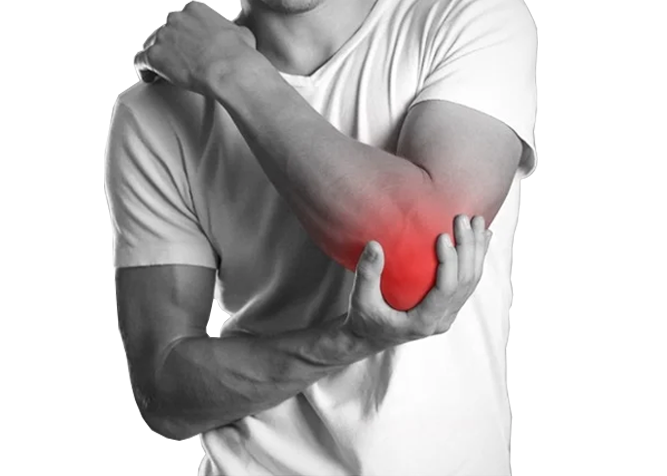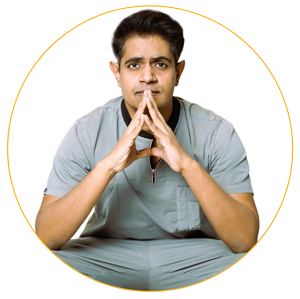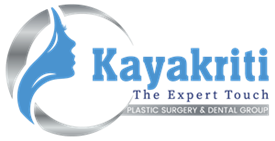Cubital Tunnel Syndrome Ulnar Nerve Palsy
Cubital Tunnel Syndrome
Compression of the ulnar nerve at the region of elbow is called Cubital tunnel syndrome.

Compression of the ulnar nerve at the region of elbow is called Cubital tunnel syndrome. Cubital Tunnel syndrome is when your ulnar nerve gets irritated or compressed (squeezed) at the inside of your elbow. Ulnar nerve provides sensation to the small finger and half of the ring finger and control fine movements of the fingers. This nerve when compressed causes numbness, tingling sensation and weakness in fingers of the hand and forearm. Electric sensation you feel in your fingers when you hit your funny bone is actually the compression of your ulnar nerve. The thumb, index finger and middle finger are typically not affected.
There are three main nerves in the arm: the median, the ulnar and the radial. The ulnar nerve goes from neck down to your arm, forearm and to your hand. Ulnar nerve goes through a tunnel called the cubital tunnel under a bony bump on the inside of the elbow called the medial epicondyle. This space is narrow, and there's only a little tissue protecting it. This is where ulnar nerve is most vulnerable to any injury or compression.
After the elbow, the ulnar nerve continues under the muscles on the inside of forearm and then into the hand through a tunnel again called Guyon's canal at the wrist region. The nerve then moves forward on the side of the hand that has little finger.
The ulnar nerve may also be affected and compressed higher on the arm or at the wrist at the Guyon's canal.
Ulnar nerve controls some of the muscles in forearm and hand which help to grip objects and perform fine movements and provide sensation to little finger and half of ring finger .
Who is at risk for cubital tunnel syndrome?
Cubital Tunnel Syndrome happens when there is increased pressure within the elbow on a nerve called the ulnar nerve.
- Pressure from casts and splints
- Arthritis of the joint.
- Keeping elbow bent for a long time.
- Projecting Bone spurs.
- Cysts near elbow joint or any tumors
- Elbow joint fracture and dislocation
Ulnar nerve can be compressed when leaned on an armrest or nerve might snap over the medial epicondyle when elbow is moved or while bending the elbow for a long time, like working on computer or sleeping, nerve might overstretch. Repeated and prolonged acts of compression, snapping and overstretching causes nerve to get inflamed and cause pain and nerve damage.
What's the difference between cubital tunnel syndrome and carpal tunnel syndrome?
Cubital tunnel syndrome affects little and ring finger. Carpal tunnel syndrome affects your thumb, index finger and middle finger.
Symptoms of cubital tunnel syndrome
Symptoms usually begin slowly and can occur at any time. Early symptoms include:
- Inner elbow and forearm pain with on and off numbness and tingling sensation in hand and little finger and ring finger
- There is perceptible difficulty in moving fingers when they're numb or tingling (falling asleep).
As cubital tunnel syndrome worsens, symptoms become more constant. These symptoms of progression include:
- Weakness in the hand.
- Inner curling of little and ring finger
- More prominent pain
- Inability to perform tasks that require delicate motions.
In the most severe condition, the muscles at the base of the little finger visibly shrink in size (atrophy) or the patient develops tiny ulcers due to burns on the fingertip of little finger.
Diagnosis of Cubital Tunnel Syndrome
Diagnosis of cubital tunnel syndrome is mostly clinical where a proper history, clinical examination and details of occupation and lifestyle help in arriving at proper diagnosis.
- Weak muscles of forearm and hand
- Decreased sensation on the palmar and backside of little finger and ring finger.
- Tinel's sign – Tapping on the wrist in the region of median nerve where elicit tingling and pain sensation in the thumb, index finger and middle finger
Few investigations are done to confirm the diagnosis-
- Nerve Conduction Velocities (NCV) and Electro-Myographic Studies (EMG) of the affected hand is quite diagnostic for cubital tunnel syndrome
- MRI of the elbow is done in few cases if any tumor or mass is suspected.
- Blood tests for diabetes or thyroid disease.
- X-rays to check for bone spurs, arthritis and places where bone might compress the ulnar nerve.
Treatment of Cubital Tunnel Syndrome
Cubital tunnel syndrome can be treated non-surgically or with surgery. Non-surgical treatments are used for less severe cases and allow you to continue with daily activities without interruption. Surgical treatments can help in more severe cases and have very positive outcomes
Non-surgical Treatments
Non-surgical treatments are usually tried first. Treatment begins by:
- Wearing a wrist splint at night to keep your elbow straight.
- Taking nonsteroidal anti-inflammatory drugs, such as ibuprofen to reduce pain and swelling around the nerve.
- Nerve gliding exercises might help ulnar nerve to slide more easily through the cubital tunnel. These exercises might also prevent stiffness in the arm and wrist.
Other treatments focus on ways to change your lifestyle to decrease symptoms. This is often seen in the workplace, where you can make modifications to help with cubital tunnel. These changes might include:
- Avoid leaning on elbow.
- Avoid putting pressure on the inside of arm.
- Don't rest elbow on computer chair / armrest
- Keep chair high
- Sleep with elbow straight.
Surgical Treatments
Surgery is recommended when cubital tunnel syndrome does not respond to non-surgical treatments or has already become severe and has caused muscle weakness.
Surgical release of cubital tunnel with anterior transposition of ulnar nerve is done. Cutting and division of the ligament which roofs the cubital tunnel-makes the tunnel bigger and decreases pressure on the ulnar nerve. Anterior transposition of the nerve will stop that from getting caught behind the medial epicondyle.
- After all the pre-operative investigations and management of diabetes and hypothyroidism, surgery is planned
- Surgery is done usually in brachial plexus block or General Anesthesia.
- A small incision is given behind the elbow and cubital tunnel is released and if required, nerve is moved anteriorly.
- Finger movements are started once the effect of brachial plexus block is gone or when the patient is out from in anaesthesia.
- You might be in brief discomfort for about 24 to 72 hours after surgery.
- Immobilization of elbow in flexion position is done till sutures are removed
- Sutures are removed after a period of 10-12 days.
- Physiotherapy post operative is most important for hand, wrist and fingers
- Prognosis is good if muscle atrophy has not started.
- You might be unable to do heavier activities with the affected hand for about four to six weeks
Surgery cannot guarantee that cubital tunnel syndrome will go away permanently. However, the outcome is generally positive.
Management of Ulnar Nerve Palsy/Leprosy/Late cases of the Cubital Tunnel Syndrome
If the patient has presented very late and muscles of hand have atrophied, then he or she would be having permanent curling of little and ring finger (inability to extend or straighten fingers at the middle and distal finger joints) and loss of fine movements of the hand with complete loss of sensation over the little and the ring finger. (ULNAR CLAW HAND)
Such condition is usually seen in long standing compression of the ulnar nerve or injuries of the ulnar nerve or in patients with leprosy.
- If the ulnar nerve is damaged, then surgical excision of the damaged part and nerve repair/grafting should be done within 1 year of the injury
- If the patient has presented with sudden onset of paralysis of ulnar nerve, then other neurological causes or leprosy should be investigated for. In many of such cases, release of cubital tunnel with anterior transposition of the nerve is done and a biopsy of the nerve fascicle and muscle is taken to confirm the diagnosis of neurological disease or leprosy
- If the patient has presented late beyond the timing suitable for nerve repair (after 1 year of the accident), then tendon transfers should be done to strengthen the weak portions of the hand along with the nerve repair and grafting. A strong tendon of the hand is re-routed to substitute a weaker or lost movement of the hand.
- If the ulnar nerve is damaged, then surgical excision of the damaged part and nerve repair/grafting should be done within 1 year of the injury
- If the patient has presented with sudden onset of paralysis of ulnar nerve, then other neurological causes or leprosy should be investigated for. In many of such cases, release of cubital tunnel with anterior transposition of the nerve is done and a biopsy of the nerve fascicle and muscle is taken to confirm the diagnosis of neurological disease or leprosy
- If the patient has presented late beyond the timing suitable for nerve repair (after 1 year of the accident), then tendon transfers should be done to strengthen the weak portions of the hand along with the nerve repair and grafting. A strong tendon of the hand is re-routed to substitute a weaker or lost movement of the hand.
During tendon transfers for ulnar nerve palsy, 2 tendons from the front of the forearm and hand are taken, re-routed and sutured to the tendons of the side of the fingers so that the patient can extend his or her fingers at their finger joints. This tendon transfer also enables a meaningful side pinch with the thumb.
The surgery is usually done under brachial block or general anaesthesia and a splint or slab is given for immobilization in the post operative period. The patient is usually discharged second day after the surgery. Sutures are removed 14 days after surgery.
Splint is removed 3 to 4 weeks after the surgery and gradual training of the transferred muscles or tendons is started so that they regain their newly assigned function.
If the patient has presented very late and muscles of hand have atrophied, then he or she would be having permanent curling of little and ring finger (inability to extend or straighten fingers at the middle and distal finger joints) and loss of fine movements of the hand with complete loss of sensation over the little and the ring finger. (ULNAR CLAW HAND)
Such condition is usually seen in long standing compression of the ulnar nerve or injuries of the ulnar nerve or in patients with leprosy.
During tendon transfers for ulnar nerve palsy, 2 tendons from the front of the forearm and hand are taken, re-routed and sutured to the tendons of the side of the fingers so that the patient can extend his or her fingers at their finger joints. This tendon transfer also enables a meaningful side pinch with the thumb.
The surgery is usually done under brachial block or general anaesthesia and a splint or slab is given for immobilization in the post operative period. The patient is usually discharged second day after the surgery. Sutures are removed 14 days after surgery.
Splint is removed 3 to 4 weeks after the surgery and gradual training of the transferred muscles or tendons is started so that they regain their newly assigned function.
Cubital Tunnel Syndrome Ulnar Nerve Palsy Images
Indivisual results may vary from person to person.
These pictures are shown for the purpose of education only.


Know your surgeon better

Best plastic surgeon, Dr. Amit Agarwal is an American Board Certified, extensively trained, and best Plastic & Aesthetic surgeon in Lucknow. He is the Chief Plastic Surgeon heading the Department of Plastic, Microvascular, and Craniofacial surgery at Vivekananda Polyclinic and Institute of Medical Sciences, Lucknow, U.P, India. He maintains a busy practice at Avadh and Nishat Hospital and his own center - Kayakriti Plastic Surgery & Dental Center. He was formerly a Consultant in the Department of Plastic Surgery and Burns at the prestigious SGPGI, Lucknow.
MS, DNB (General Surgery) MCh, DNB (Plastic Surgery),
MNAMS, FACS, FICS, FRCS (Edinburgh, UK)
His Credentials
Three pillars of kayakriti
Privacy
We believe your experience with us should be comfortable and hassle-free to make it one of your best lifetime experiences for yours. We, here at the clinic, take full precautions to maintain your privacy in any manner. We also provide a staff who will receive you from the gate and take you to the chamber directly if you demand.
Trust
Our Surgeon is highly qualified and internationally certified with a team of skilled staff to perform any surgical or non-surgical treatment on your body.
Safety
When you plan to undergo any surgery you should always keep in mind that it's your body and it's a surgery. We, here always keep your safety a priority and will never recommend you to undergo any such procedure which is not safe for you. We also provide you with a detailed description of the complications which may occur after the surgery during the consultation as it's a surgical procedure so there may be some complications depending on the way your body reacts.
Kayakriti in news



Frequently Asked Questions
If you have flat or small breast and you want to improve your breast and hip contour ratio then you are a good candidate for it. The answer will be best provided after the first consultation with Dr Amit Agarwal.
Acute pain will be there for almost a week which gradually reduces and there will be soreness and swelling which may take up to 3 weeks to subside.
You can join your work and daily routines after a week of the procedure and can start exercising after 3 weeks of it.
Yes, you have to wear it round the clock unless we suggest you to remove it.
This surgery does not affect the ducts or the areas of the breast involved in milk production. Thus, it does not affect the breast feeding.
This surgery does not affect the ducts or the areas of the breast involved in milk production. Thus, it does not affect the breast feeding.












Kayakriti Plastic Surgery & Dental Center
D-43, Near Punjab National Bank, Rajajipuram, Lucknow, Uttar Pradesh - 226017, India
Phone No. +919695940009, +919695940006
Map Location





























Social Media Presence